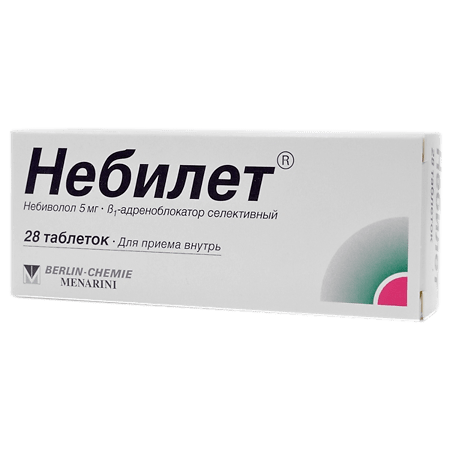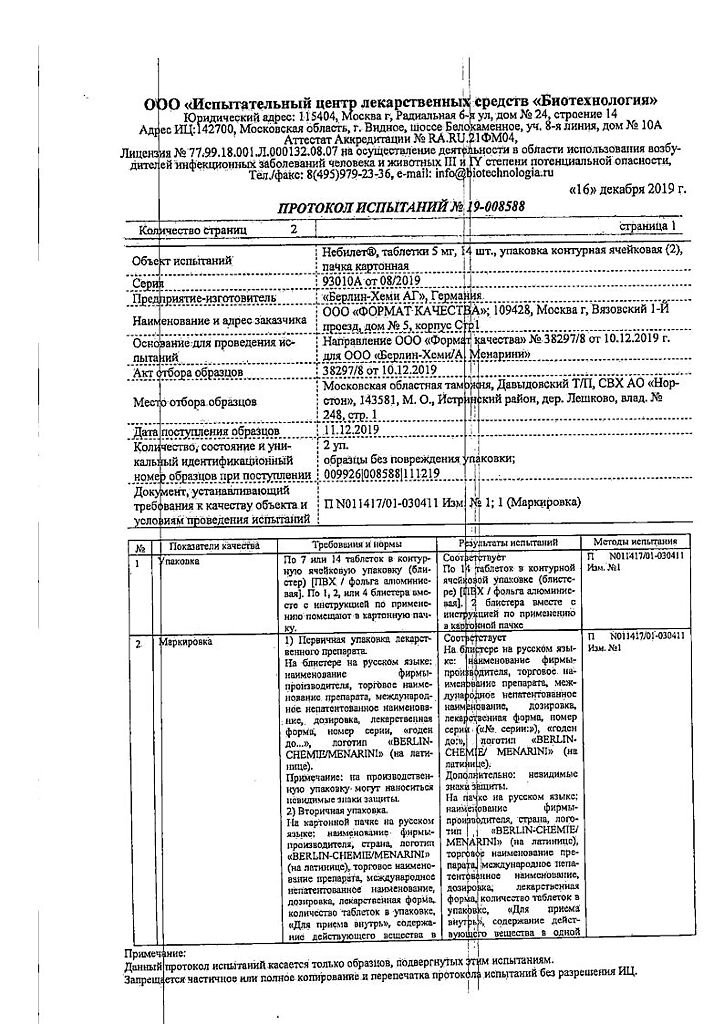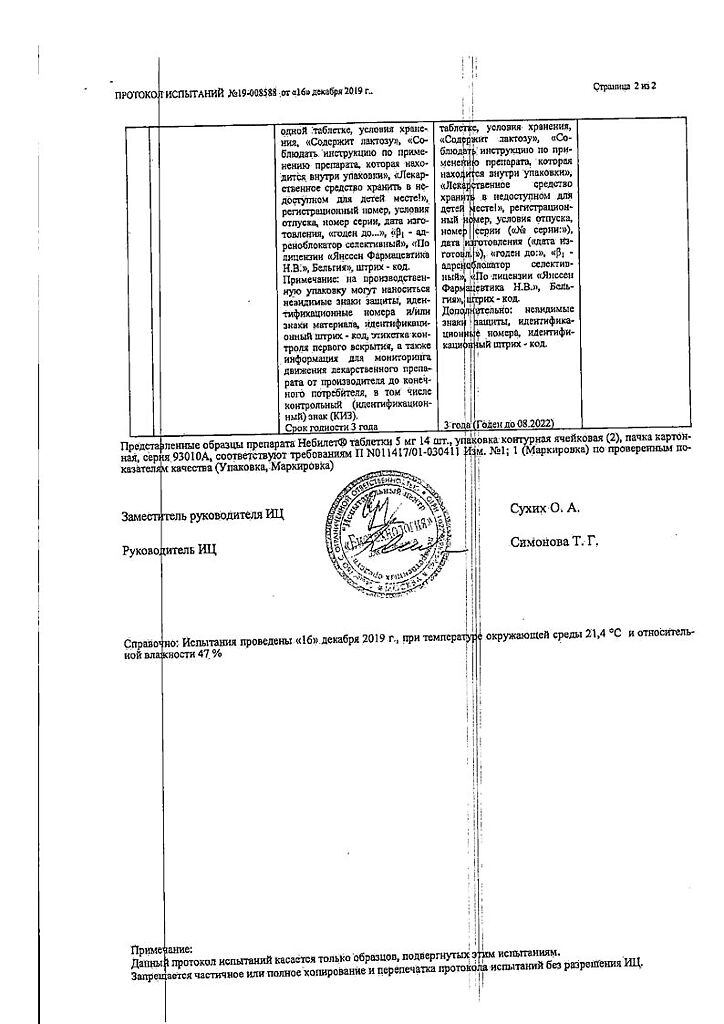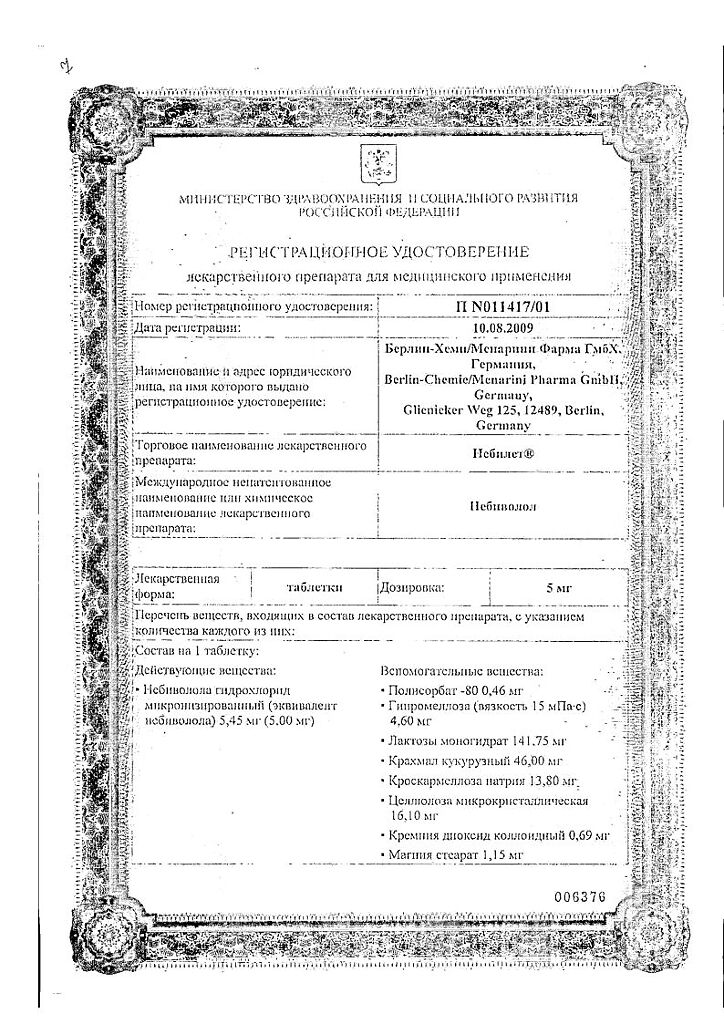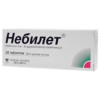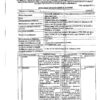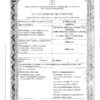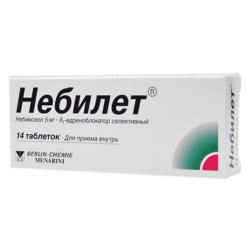No products in the cart.
Nebilet, tablets 5 mg 28 pcs
€36.65 €30.54
Description
Pharmacodynamics
A cardioselective beta 1-adrenoblocker. It has hypotensive, antianginal and antiarrhythmic effects. Reduces elevated BP at rest, under physical stress and stress. Competitively and selectively blocks postsynaptic β1-adrenoreceptors, making them unavailable for catecholamines, modulates the release of endothelial vasodilatory factor nitric oxide (NO).
Nebivololol is a racemate of two enantiomers: SRRR-nebivolol (D-nebivolol) and RSSS-nebivolol (L-nebivolol) combining two pharmacological actions:
– D-nebivololol is a competitive and highly selective blocker of β1-adrenoreceptors;
– L-nebivololol has a mild vasodilator effect by modulating the release of vasodilatory factor (NO) from the vascular endothelium.
The hypotensive effect is also due to decrease of renin-angiotensin-aldosterone system (RAAS) activity (does not directly correlate with changes in plasma renin activity).
Sustained hypotensive effect develops after 1-2 weeks of regular use of the drug, and in some cases – after 4 weeks, a stable effect is noted after 1-2 months.
Limiting myocardial oxygen demand (decrease in HR and decrease in ante- and post-load), it reduces the number and severity of angina attacks and increases exercise tolerance.
The antiarrhythmic action is due to the suppression of pathological automatism of the heart (including in the pathological focus) and the slowing of AV conduction.
Pharmacokinetics
absorption
After oral administration, both enantiomers are rapidly absorbed. Food intake has no effect on absorption, so nebivolol can be taken regardless of meals. The bioavailability of nebivolol after oral administration averages 12% in those with “fast” metabolism (first-pass effect through the liver) and is almost complete in those with “slow” metabolism.
Distribution
In plasma both enantiomers are predominantly bound to albumin. Binding to plasma proteins is 98.1% for D-nebivololol and 97.9% for L-nebivololol.
Metabolism
Metabolized by acyclic and aromatic hydroxylation and partial N-dealkylation. The resulting hydroxy- and amino derivatives conjugate with glucuronic acid and are excreted as O- and N-glucuronides.
Elimination
Extracted by the kidneys (38%) and through the intestine (48%). In persons with “fast” metabolism T1/2 of hydroxymetabolites is 24 h, enantiomers of nebivololol – 10 h; in persons with “slow” metabolism: hydroxymetabolites – 48 h, enantiomers of nebivololol – 30-50 h.
The urinary excretion of unchanged nebivololol is less than 0.5% of the amount of the drug taken orally.
Indications
Indications
Coronary heart disease: prevention of angina attacks; arterial hypertension; chronic heart failure (as part of combination therapy).
Pharmacological effect
Pharmacological effect
Pharmacodynamics
Cardioselective beta 1-blocker. It has hypotensive, antianginal and antiarrhythmic effects. Reduces high blood pressure at rest, during physical exertion and stress. Competitively and selectively blocks postsynaptic β1-adrenergic receptors, making them inaccessible to catecholamines, modulates the release of endothelial vasodilating factor nitric oxide (NO).
Nebivolol is a racemate of two enantiomers: SRRR-nebivolol (D-nebivolol) and RSSS-nebivolol (L-nebivolol), combining two pharmacological actions:
— D-nebivolol is a competitive and highly selective β1-adrenergic receptor blocker;
— L-nebivolol has a mild vasodilatory effect by modulating the release of vasodilating factor (NO) from the vascular endothelium.
The hypotensive effect is also due to a decrease in the activity of the renin-angiotensin-aldosterone system (RAAS) (does not directly correlate with changes in renin activity in the blood plasma).
A stable hypotensive effect develops after 1-2 weeks of regular use of the drug, and in some cases – after 4 weeks; a stable effect is observed after 1-2 months.
By reducing myocardial oxygen demand (reducing heart rate and reducing preload and afterload), it reduces the number and severity of angina attacks and increases exercise tolerance.
The antiarrhythmic effect is due to the suppression of pathological automatism of the heart (including in the pathological focus) and slowdown of AV conduction.
Pharmacokinetics
Suction
After oral administration, both enantiomers are rapidly absorbed. Food intake does not affect absorption, so nebivolol can be taken regardless of meals. The bioavailability of nebivolol after oral administration averages 12% in rapid metabolizers (first pass effect through the liver) and is almost complete in slow metabolizers.
Distribution
In blood plasma, both enantiomers are predominantly associated with albumin. Plasma protein binding for D-nebivolol is 98.1%, and for L-nebivolol is 97.9%.
Metabolism
Metabolized by acyclic and aromatic hydroxylation and partial N-dealkylation. The resulting hydroxy and amino derivatives are conjugated with glucuronic acid and are excreted in the form of O- and N-glucuronides.
Removal
Excreted by the kidneys (38%) and through the intestines (48%). In persons with “fast” metabolism T1/2 of hydroxymetabolites – 24 hours, enantiomers of nebivolol – 10 hours; in persons with “slow” metabolism: hydroxymetabolites – 48 hours, nebivolol enantiomers – 30-50 hours.
Excretion of unchanged nebivolol in urine is less than 0.5% of the amount of the drug taken orally.
Special instructions
Special instructions
The withdrawal of beta-blockers should be carried out gradually over 10 days (up to 2 weeks in patients with coronary artery disease).
Monitoring blood pressure and heart rate at the beginning of taking the drug should be daily.
In elderly patients, monitoring of kidney function is necessary (once every 4-5 months).
For exertional angina, the dose of the drug should ensure that the heart rate at rest is within the range of 55-60 beats/min, and during exercise – no more than 110 beats/min.
Beta-blockers can cause bradycardia: the dose should be reduced if the heart rate is less than 50-55 beats/min.
When deciding on the use of Nebilet® in patients with psoriasis, one should carefully weigh the expected benefits of using the drug and the possible risk of exacerbation of psoriasis.
Patients who use contact lenses should take into account that the use of beta-blockers may reduce the production of tear fluid.
When performing surgical interventions, the anesthesiologist should be warned that the patient is taking beta-blockers.
Nebivolol does not affect plasma glucose concentrations in patients with diabetes mellitus. However, caution should be exercised when treating these patients because Nebilet may mask certain symptoms of hypoglycemia (eg, tachycardia) caused by the use of oral hypoglycemic agents and insulin.
Monitoring the concentration of glucose in the blood plasma should be carried out once every 4-5 months (in patients with diabetes mellitus).
With hyperthyroidism, beta-blockers can mask tachycardia.
Beta blockers should be used with caution in patients with chronic obstructive pulmonary disease, as bronchospasm may increase.
Beta blockers may increase sensitivity to allergens and the severity of anaphylactic reactions.
Impact on the ability to drive vehicles and other mechanisms that require increased concentration
The effect of Nebilet® on the ability to drive vehicles and operate machinery has not been specifically studied. Pharmacodynamic studies of nebivolol have shown that Nebilet® does not affect psychomotor function.
During treatment with Nebilet® (if side effects occur), caution should be exercised when driving vehicles and when engaging in potentially hazardous activities that require increased concentration and speed of psychomotor reactions.
Active ingredient
Active ingredient
Nebivolol
Composition
Composition
Active ingredients:
nebivolol hydrochloride micronized 5.45 mg, which corresponds to the content of nebivolol 5 mg.
Excipients:
lactose monohydrate – 141.75 mg,
corn starch – 46 mg,
sodium croscarmellose – 13.8 mg,
hypromellose 15 mPa×s – 4.6 mg,
polysorbate 80 – 0.46 mg,
microcrystalline cellulose – 16.1 mg,
colloidal silicon dioxide – 0.69 mg,
magnesium stearate – 1.15 mg.
Pregnancy
Pregnancy
Nebivolol is excreted in breast milk. If it is necessary to take Nebilet® during lactation, breastfeeding should be stopped.
During pregnancy, Nebilet® is prescribed only for vital indications, when the benefit to the mother outweighs the possible risk to the fetus or newborn (due to the possible development of bradycardia, arterial hypotension, and hypoglycemia in the fetus and newborn). If treatment with Nebilet® is necessary, uteroplacental blood flow and fetal growth should be monitored.
Treatment must be interrupted 48-72 hours before delivery. In cases where this is not possible, it is necessary to establish strict monitoring of newborns for 48-72 hours after delivery.
Contraindications
Contraindications
– Hypersensitivity to nebivolol or one of the components of the drug;
– chronic heart failure in the stage of decompensation (requiring intravenous administration of drugs with inotropic effects);
– acute heart failure;
– SSSU, including sinoatrial block;
– AV block II and III degrees (without artificial pacemaker);
– severe arterial hypotension (systolic blood pressure less than 90 mm Hg);
-cardiogenic shock;
– pheochromocytoma (without simultaneous use of alpha-blockers);
– metabolic acidosis;
– myasthenia;
– severe liver dysfunction;
– bradycardia (heart rate less than 60 beats/min);
– severe obliterating diseases of peripheral vessels (intermittent claudication, Raynaud’s syndrome);
– history of bronchospasm and bronchial asthma;
– depression;
– lactose intolerance, lactase deficiency and glucose/galactose malabsorption syndrome;
– children and adolescents under 18 years of age (efficacy and safety have not been studied).
Use the drug with caution:
– in case of renal failure,
– diabetes mellitus,
– hyperfunction of the thyroid gland,
– history of allergic diseases,
– psoriasis,
– chronic obstructive pulmonary disease, A
– V-blockade of the 1st degree,
– Prinzmetal’s angina,
– patients over 75 years of age.
Side Effects
Side Effects
Frequency of side effects: uncommon (> 0.1% and 10%); often (> 1% and < 10%); very rare (0.01% and <0.1%).From the cardiovascular system: infrequently – bradycardia, acute heart failure, AV block, orthostatic hypotension, Raynaud’s syndrome.From the central nervous system and peripheral nervous system: often – headache, dizziness, increased fatigue, weakness, paresthesia; infrequently – depression, nightmares, confusion; very rarely – fainting, hallucinations.From the skin and subcutaneous tissues: infrequently – erythematous skin rash, itching; very rarely – aggravation of psoriasis; in some cases – angioedema.From the digestive system: often – nausea, constipation, diarrhea; infrequently – dyspepsia, flatulence, vomiting.Other: infrequently – bronchospasm; rarely – dry eyes.
Interaction
Interaction
Pharmacokinetic interaction
With simultaneous use of nebivolol with drugs that inhibit serotonin reuptake, or other drugs that are biotransformed with the participation of the CYP2D6 isoenzyme, the concentration of nebivolol in the blood plasma increases, the metabolism of nebivolol slows down, which can lead to the risk of bradycardia.
When used concomitantly with digoxin, nebivolol does not affect the pharmacokinetic parameters of digoxin.
With simultaneous use of nebivolol with cimetidine, the concentration of nebivolol in the blood plasma increases.
The simultaneous use of nebivolol and ranitidine does not affect the pharmacokinetic parameters of nebivolol.
With simultaneous use of nebivolol with nicardipine, the concentrations of active substances in the blood plasma increase slightly, but this does not have clinical significance.
Concomitant use of nebivolol and ethanol, furosemide or hydrochlorothiazide does not affect the pharmacokinetics of nebivolol.
No clinically significant interaction between nebivolol and warfarin has been established.
When nebivolol is used concomitantly with insulin and oral hypoglycemic agents, the symptoms of hypoglycemia (tachycardia) may be masked.
Pharmacodynamic interaction
With the simultaneous use of beta-blockers with blockers of slow calcium channels (verapamil and diltiazem), the negative effect on myocardial contractility and AV conductivity increases.
IV administration of verapamil is contraindicated while using nebivolol.
When nebivolol is used simultaneously with antihypertensive drugs, nitroglycerin or slow calcium channel blockers, severe arterial hypotension may develop (special caution is required when combined with prazosin).
With the simultaneous use of nebivolol with class I antiarrhythmic drugs and amiodarone, the negative inotropic effect may be enhanced and the time of excitation through the atria may be prolonged.
With simultaneous use of nebivolol with cardiac glycosides, there was no increase in the effect on slowing down AV conduction.
The simultaneous use of nebivolol and drugs for general anesthesia may suppress reflex tachycardia and increase the risk of developing arterial hypotension.
There is no clinically significant interaction between nebivolol and NSAIDs.
Concomitant use of nebivolol with tricyclic antidepressants, barbiturates and phenothiazine derivatives may enhance the hypotensive effect of nebivolol.
Overdose
Overdose
Symptoms: marked decrease in blood pressure, nausea, vomiting, cyanosis, sinus bradycardia, AV block, bronchospasm, loss of consciousness, cardiogenic shock, coma, cardiac arrest.
Treatment: gastric lavage, taking activated carbon. In case of a pronounced decrease in blood pressure, it is necessary to place the patient in a horizontal position with elevated legs, and, if necessary, administer intravenous fluids and vasopressors.
For bradycardia, 0.5-2 mg of atropine should be administered intravenously; if there is no positive effect, a transvenous or intracardiac pacemaker may be installed.
In case of AV blockade (II-III stage), intravenous administration of beta-adrenergic stimulants is recommended; if they are ineffective, the issue of installing an artificial pacemaker should be considered.
In case of heart failure, treatment begins with the administration of cardiac glycosides and diuretics; if there is no effect, it is advisable to administer dopamine, dobutamine or vasodilators.
For bronchospasm, IV β2-adrenergic receptor stimulators are used.
For ventricular estracystole – lidocaine (class IA antiarrhythmic drugs cannot be administered).
Storage conditions
Storage conditions
Store out of the reach of children at a temperature not exceeding 25°C.
Shelf life
Shelf life
3 years.
Manufacturer
Manufacturer
Berlin-Chemie AG, Germany
Additional information
| Shelf life | 3 years. |
|---|---|
| Conditions of storage | Keep out of the reach of children at temperatures under 25°C. |
| Manufacturer | Berlin-Chemie AG, Germany |
| Medication form | pills |
| Brand | Berlin-Chemie AG |
Other forms…
Related products
Buy Nebilet, tablets 5 mg 28 pcs with delivery to USA, UK, Europe and over 120 other countries.

